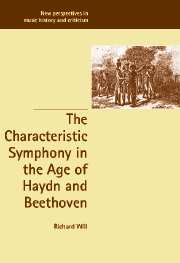Book contents
- Frontmatter
- Contents
- Acknowledgments
- Note to the reader
- Introduction
- 1 Paradise lost: Dittersdorf's Four Ages of the World and the crisis of Austrian enlightened despotism
- 2 Preaching without words: Reform Catholicism versus divine mystery in Haydn's Seven Last Words
- 3 The boundaries of the art: characteristic music in contemporary criticism and aesthetics
- 4 Paradise regained: time, morality, and humanity in Beethoven's Pastoral Symphony
- 5 Making memories: symphonies of war, death, and celebration
- Appendixes
- Bibliography
- Index
2 - Preaching without words: Reform Catholicism versus divine mystery in Haydn's Seven Last Words
Published online by Cambridge University Press: 11 January 2010
- Frontmatter
- Contents
- Acknowledgments
- Note to the reader
- Introduction
- 1 Paradise lost: Dittersdorf's Four Ages of the World and the crisis of Austrian enlightened despotism
- 2 Preaching without words: Reform Catholicism versus divine mystery in Haydn's Seven Last Words
- 3 The boundaries of the art: characteristic music in contemporary criticism and aesthetics
- 4 Paradise regained: time, morality, and humanity in Beethoven's Pastoral Symphony
- 5 Making memories: symphonies of war, death, and celebration
- Appendixes
- Bibliography
- Index
Summary
The Seven Last Words of our Savior on the Cross posed still greater challenges to contemporary listeners than had the Metamorphoses symphonies. Commissioned to write music for a Good Friday observance in Cádiz, Spain, Haydn produced seven slow movements based on the utterances or “words” of the crucified Christ. In the original service each movement followed a reading and explication of the associated text, with an Introduzione, also slow, at the beginning, and a Presto, a depiction of the earthquake triggered by Christ's death, at the end. In concert, as the work was soon heard in Vienna, Paris, Berlin, London, and elsewhere, it proposed that music could guide listeners through the narrative crux of Christianity with only minimal assistance from language. It also stepped square into a debate over religion and religious music that was raging throughout Europe and particularly in Josephinian Austria, not the milieu for which Haydn's movements were originally intended but the one in which he, like Dittersdorf, lived and worked. Joseph extended his reforms of the empire to the church, putting special emphasis on preaching as a medium for conveying religious truth and recommending that homilies take a single lesson from the day's Gospel reading and explain it in such a way as both to engage the intellect and to touch the heart.
- Type
- Chapter
- Information
- Publisher: Cambridge University PressPrint publication year: 2002



